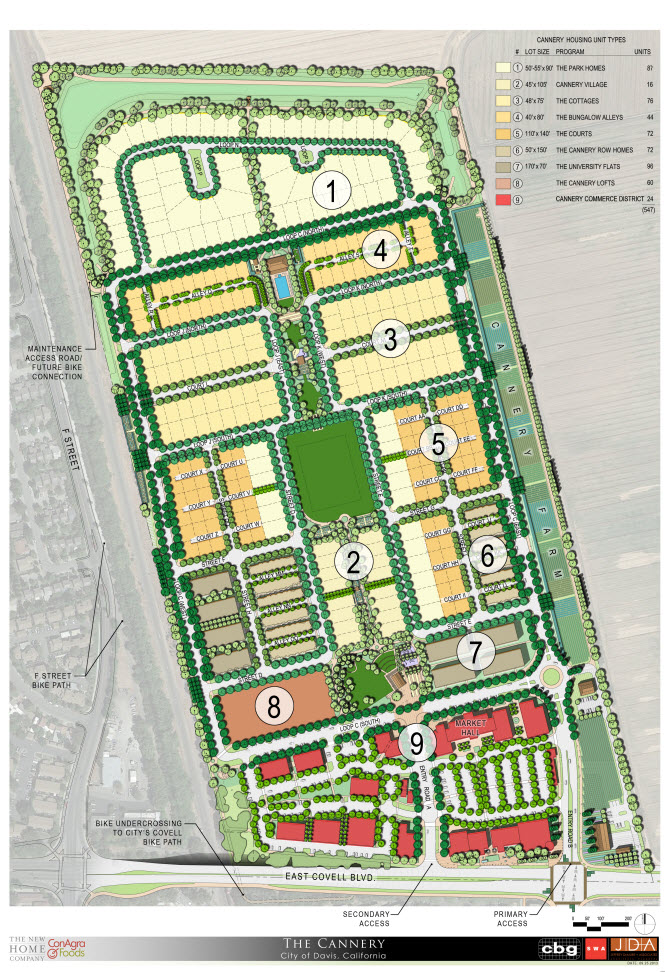 By Matt Williams
By Matt Williams
At the beginning of Tuesday night’s Staff presentation Mike Webb stepped through the key components of the Development Agreement and then turned the microphone over to Ashley Feeney and Mary Jo Bryan for the announcement of the Monday agreement reached by New Home Company and Choices for Healthy Aging (CHA). Taken together those elements represented the culmination of a whole lot of listening by the ConAgra/New Home Company team, and a whole lot of persistence by the many and varied interest groups around Davis that felt they had a vested interest in the Cannery project.
Although it often appeared to be more painful than it needed to be, that process is a textbook example of the old adage that the whole is greater than the sum of its parts. It could also be called a Win-Win agreement.
What were those Wins?
The first win came for the Small Builders Group (of which there were 25 in attendance on Tuesday night). They got a known stream of future projects that would add both local income and local jobs to the Davis economy in the three-year period from late 2014 through 2017. In the process some of the members of CHA will get the opportunity to have a custom built single story home if they don’t feel that they like any of the “standard” single story designs that came out of the CHA/New Home Company agreement. When this Small Builders issue first came up several months ago it had all the appearance of an “irresistible force meets an immovable object” impasse. However, the immovable object proved to be not so immovable, and what could have been the creation of powerful opposition to the project was transformed into vocal support from two key Davis constituencies, the business community and seniors.
The second win came for Energy Sustainability and the reduction of Greenhouse Gases, which Davis has prioritized as a community goal. When this issue first came up in the Natural Resources Commission public hearing and at the Valley Climate Action Center workshop at Blue Oak Energy, it too had the appearance of an “irresistible force meets an immovable object” impasse. But, again New Home Company avoided being the immovable object and all the single family homes in the Cannery will have 1.5 kilowatts of solar power generation, and further, no less than 25% of those single family homes will be Net Zero Electricity. Here too a potential powerful opposition to the project by the sustainable energy community and all the supporters of the Cool Davis initiative was transformed into vocal support from those key Davis constituencies.
The third win was the aforementioned agreement between CHA and New Home Company regarding the single story home options
The rest of this article is going to focus on the fourth win . . . connectivity and transportation.
The following table is taken from page 101 of Tuesday’s Staff Report
What quickly becomes clear is that connectivity and transportation is a complex and costly endeavor. Adding up the amounts in the last three columns, the total contribution of the Cannery comes to over $11 million of the over $15 million that will be put into the East Covell Corridor under the auspices of the CBCP (Covell Boulevard Corridor Plan). That is a very substantial investment by both our community and the Cannery in the kind of quality of life amenities that make Davis what it is. The goals of the CBCP are to:
-
Enhance mobility on East Covell Corridor for all modes of travel . . . auto, bicycle and pedestrian,
-
Enhance bicycle and pedestrian neighborhood connectivity, and
-
Enhance corridor identity and aesthetics
The CBCP held its first Community Workshop on May 23, 2013 (see http://community-development.cityofdavis.org/Media/Default/Documents/PDF/CDD/Transportation-Planning/East-Covell-Corridor-Plan/Davis_Community Open House Summary_REV2.pdf )
And will be holding one or more future workshops to be sure that the Davis citizens are engaged.
In addition to the above three goals the CBCP will have a fourth goal of slowing down auto speeds on Covell, which studies show regularly exceed the posted speed limits. The steps that will be taken to accomplish that fourth goal are:
-
Narrowing of automobile lanes and creation of dedicated bicycle lanes.
-
Remove all the “free right turns” at the four intersections (F, J, L and Pole Line)
-
Install a new traffic light at L Street and Covell , which will create spaces of time where a red light arrests through passage on Covell, thereby providing better access into and out of Oak Tree Plaza
-
Complete the shared use paths along the north side of the corridor between J and Pole Line, as well as up the west side of Pole Line from Covell to the City Limits
The graphic below shows the area that the Corridor covers from F Street to Birch Lane.
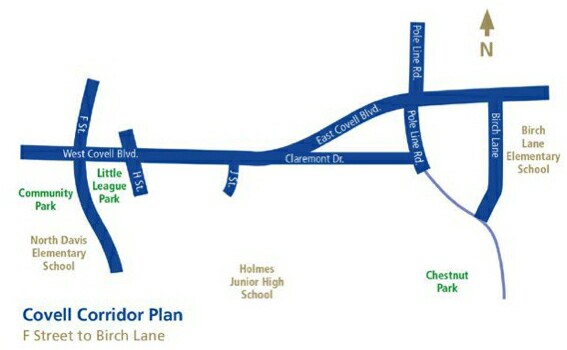
Within that CBCP are a second grade separated crossing either at L Street or between J Street and L Street, as well as a commitment by all the parties to actively pursue connecting the Southwest corner underpass down to the H Street Tunnel. These two solutions are what the bicycle community and many others from all across Davis have been advocating for, and while there may still be challenges that cause the commitment to these two solutions not to work out as currently planned, I don’t think there is any shortage of commitment on the part of the Cannery or the City.
The Southeast crossing will most likely be a tunnel, with the configuration and location still being discussed. The following three graphics depict options that were presented Tuesday night.

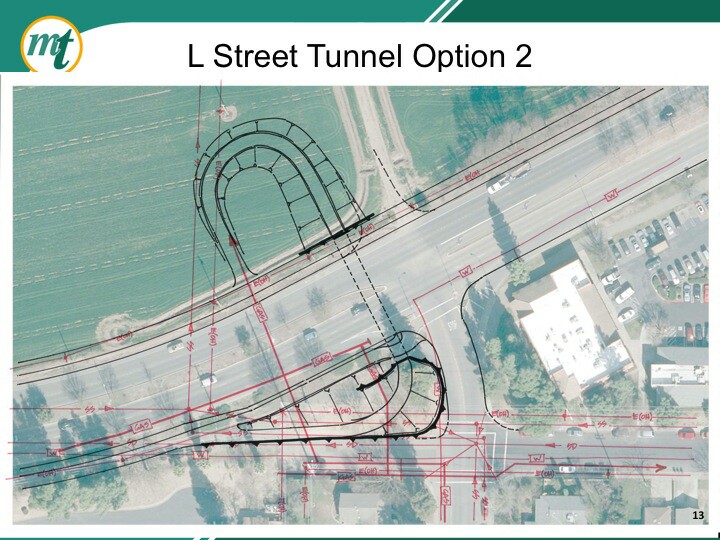
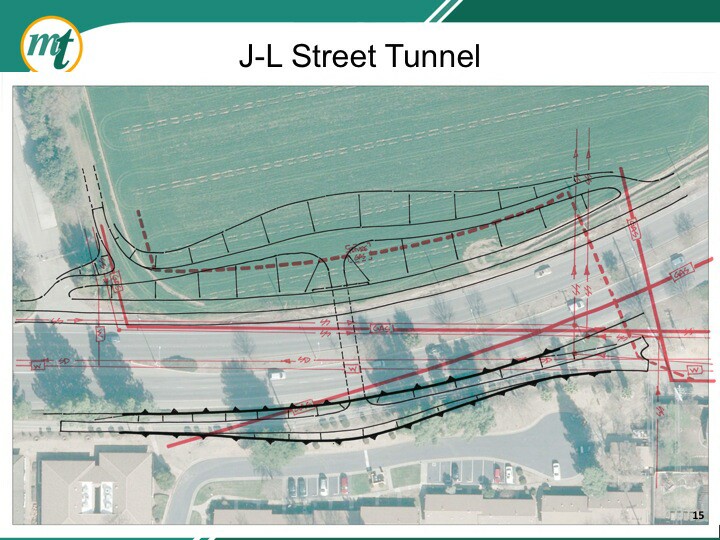
Another alternative would be to avoid all the gas lines and water mains issues (that are shown as the red lines in the graphics) by building an overpass. The challenge with an overpass is twofold. First it requires a 20 foot rise and fall from ground level to the top of the overpass, while a tunnel only requires a 12 foot rise and fall, and second, that means the long ramp either extends far into the adjacent property or curls like a pretzel. The graphic below shows both those problems.

As the CBCP is finalized in early 2014 and then adopted by Council, these options will be thoroughly explored and vetted through the Commissions and the second CBCP Workshop.
That leaves the Southwest connection as the last win opportunity. What Tuesday night clearly demonstrated was that the focus on the connectivity issue on the Southwest has shifted from the developer to the Council, and that the focus of the Davis bicycle community will indeed be on the Council in the coming weeks and months as the details of the direct connection down to the H Street Tunnel is pursued. The Staff Report does an excellent job of summarizing the key issues, so I reproduce it here as-is.
As Mayor Krovoza and Council member Frerichs pointed out on Tuesday the southwest bicycle grade separated crossing needs the negotiation of the easement along apartment border, and that until that easement is agreed to there is not currently a guaranteed pathway to success. It has only been in the past two weeks that Staff has been able to walk the “very tight site” between the apartment and the rail right of way, and details from that recently started process are still needed.
Even if the easement is successfully obtained, Council member Frerichs noted that improvement of H Street Tunnel is important as well.
There are still miles to go before we sleep, but the outlook is much less frosty after the events of Tuesday night.


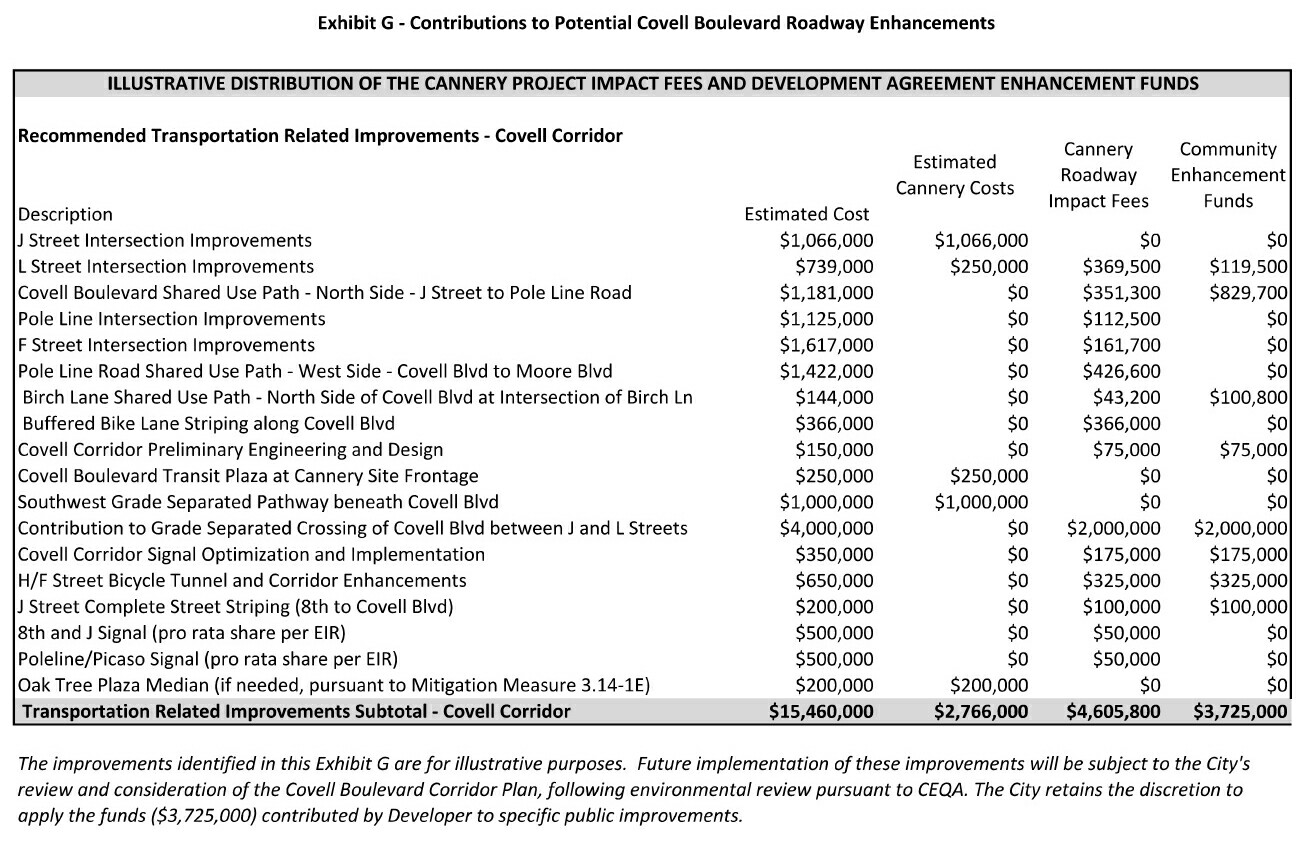


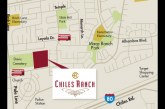
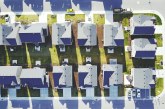
it seems like conagra caved at the end to every group that pressed them for more. i guess we should have pressed them too.
Posted this over on the Enterprise article by Dunning as well.
Dunning: “I think it would be the right thing to do for business development in this town to support the existing organizations that are working well in collaboration with the city.”
And I think a private entity has the right to donate funding to whomever they want and don’t have to wait for Joe Krovoza’s permission to do it.
Amen Ron, Amen
I think this is a pretty great project and place to live. And how it is being built acknowledges lot of needs of seniors, and a few luckily families will “win the lottery” and get an affordable home. And a few lucky small builders will get some work. This is all important stuff. This will be a great Davis Neighborhood..
But look at this from a Macro-Economic balance sheet- which no-one other than Mayor Krovoza —seems to be doing. This development will be a Net Loss of quality of life for 95% of all other Davis Residents.
We have socialized the Risk of cost over runs and unknown factors to build the needed bike and traffic fixes from the Cannery to all other City residents. “Putting it on the back of tax payers” as Krovoza described it on Oct 22nd. The reason we don’t have costs is the Cannery is in a hurry for City OK –and have not yet contact PGE about cost of utility relocation along Covell for the bike tunnels—or fully resolve the cost of a bike connection to H street. They of course are served well by this ignorance as what have not be identified, the city can’t ask them to pay for.
So, why should other City residents be asked to absorb this cost-risk based on the Urgency of the Developer to start work?
And, to pay for the city portion of the Covell Blvdrfix, all other bike, and pedestrian and traffic improvements everywhere else in the city will be put on hold. With our under-maintained pot-holed neighborhood streets in Davis, people will ask why are we dedicating so much of general fund money on fixing roads by the Cannery?
As it stands the Rest of the City’s residents are getting very little or no direct benefits to compensate for the dramatic increase in traffic on Covell that will flood down G,J and L. Let’s put number on just the traffic congestion: If you value Davisite’s times at just $10/hour, and assume each existing trip down Covell (19000/day) will be delayed 1 minute at just one of the retimed lights or the two additional ones that will be added — that amounts to about $1 million/year in lost time—forever. This is a CANNERY TAX on all Davites.
And to put the road costs in perspective by noting what we Davisites are directly giving the Developer: An Entitlement to build Homes with access to Great Schools, bike infrastracture, churches, social action, cultural institution. This has real value we can put a number concrete number on: People are wiling to pay over $100 sq ft more for home in Davis compared to Woodland, Roseville, Folsom, etc. $285 sq ft or about a 50% premium. With 547 home with an average prices of 450,000, that means the developer can sell these home–which cost no more to build in Davis than in Woodland- for an agregate of $80 Million. This premium has accrued since about 1990 if you look back historically as real estate prices
Who built this Value? Certainly not the Cannery’s land owner or developer who has paid prop 13 property taxes…but the residents of Davis who have taxed themselves extra for parks, school, library, and made wise political decisions to preserve a viable downtown. Even those who moved in during this period have paid-in—they paid-a premiuim to those residents who built this value and are now “cashing out”.
So, when we “entitle” the Developer to build these 547 homes, who get the benefit of this $80 Million windfall – The People who created the value, or the land speculator who sat passively by and watched?
I find it pretty amazing our schools-who created most of this $80 million– are getting nothing special from the deal, and our parks are settling only $2 million. Given this, why is the City council even arguing about having the Developer absorb all the cost and risk and fully pay to mitigate the traffic the Cannery is causing by Upgrading Covell–what ever it costs?
We’ve socializing the Risk and costs and privatizing the windfall profit from this development.
This is project goes thru, and once the community experiences the traffic delay it will create on Covell and once citizens realize the city did not negotiate sufficient funds to fully mitigation the problem, it will be accountability time.
The Cannery will be revealed as the “give away” to private interest it really is.
Those pro-growth City Council reps should remember this—and they will have a snowballs change in hell to get the voters to approve of any expansion of city growth boundaries for a tech park or anything else.
“This development will be a Net Loss of quality of life for 95% of all other Davis Residents.”
Agreed.
ConAgra did not Cave. They agreed that these transportation fixes were needed….but Reporter Matt Williams and other missed the fact the developer Caped their contributions to build them at the previous dollar amount–so agreeing to the fixes were meaningless.
They just transferred of Cost/Risk to the city.
Very clever PR.
ConAgra/New Home company wants to lock in its cost for construction of these transportation improvements —before the are designed and bid out, probably arguing this is what is needed before they can go forward.
But lets review that arguments; they don’t have a lock on any other costs in the project. So this lock on cost is entirely unnecessary.
Why should the city tax payers should accept the risk of unknown costs for improvement that only benefit the development? If developer needs a lock on cost, we can wait until design is done to reduce the risk==otherwise, its only fair the Developer–not the residents of Davis=-should absorb the cost/risk. Just like other components of the development agreement, we can write in a performance spec==build two grade-separated connectors across covell, one to the H street Tunnel—not a locked-cost-contribution to something TBD.
p.s. if ConAgra has #2 Million to give away to a Davis non-profit of their choosing to get support for this project, they clearly have extra profit margin- a sign city is leaving money on the table in making them contribution to transportation and other improvements in the city.
“So, when we “entitle” the Developer to build these 547 homes, who get the benefit of this $80 Million windfall – The People who created the value, or the land speculator who sat passively by and watched? “
The windfall for the developer you describe equates to one dollar/sq.ft. in extra property taxes paid annually plus the windfall to the schools, parks, open space and library from these new parcels paying into our tax system. These houses will also reduce the fixed cost/ parcel for the new water and sewer projects. If the new residents who move there do any shopping in town they will add sales tax revenue to the city. Also, if they have children in our schools much needed funding will be brought into our school system. So it seems you aren’t looking at the whole balance sheet.
Still your bigger flaw is the idea that your assumed $80 million windfall is from something Davis did when in reality it results from something we didn’t do, build many houses in the last 15 years. Restricting supply has driven up house prices and as a result the $100 / sq.ft. differential exists. Any person who owned real estate benefitted for doing nothing over these years. I have a friend who accumulated a portfolio of rental houses in Davis over his career as a teacher. At one point the value of his holdings was increasing by $1,000,000/year.
I imagine that since Conagra wants its land rezoned you think its different but that discounts the almost 40 years of contributing to our local economy providing jobs to workers and aggregation, distribution and marketing services for local farmers.
The reality is that building houses is lucrative because of restricted supply driving up profit margins. Sadly as long as we maintain imbalances between supply and demand for housing our prices for housing will remain high and those that can find a way to get lots to build on will make a nice profit. The only way you can reduce the margins are by demanding features, something Cannery has done to the extreme, or by building additional housing that brings supply into balance with demand.
Also, Conagra isn’t a speculator. They are the owner of a brownfield site in need of redevelopment as a result of globalization in the tomato industry. Unlike most old factory sites this one happens to be quite valuable. They are simply like any other property owner trying to get the best value they can out of a stranded asset. It is not their fault that local politics has made that property so valuable.
Toad, just curious. Are your teacher friend’s initials RS?
Nope.
I agree with Ron. It is so apparent that the Mayor is over-reaching and is also starting to show a really mean-spirited side of him that has not been apparent before. Not very leadership-like for someone running for Assembly. No one likes a bully or will vote for one.
I’ll happily vote for him, for a lot of very good reasons. Ron is, of course, correct that private businesses can donate to whomever they choose. But I think their reasons for doing so raise many valid questions.
Ah Davis, let no good deed go unpunished. So these guys pledge to give $2 million to a non-profit and the answer from the mayor isn’t thank you on behalf of the community its why didn’t you give $2 million to a non-profit that the mayor approves of. Never mind that the non-profit the mayor suggested didn’t exist when Conagra made the pledge. It was embarrassing to watch the shameful way the mayor publicly berated the representative from Conagra. I’ve tried to stay out of choosing sides between Joe and Dan in my remarks on this site and will continue to do so and i want to remove my remarks here, right now, from the context of making that choice. Having stated that I do want to say I thought the mayor’s behavior was unbecoming of his office as the leader of this community.
Mr. Toad
[quote]I’ve tried to stay out of choosing sides between Joe and Dan in my remarks on this site and will continue to do so and i want to remove my remarks here, right now, from the context of making that choice. Having stated that I do want to say I thought the mayor’s behavior was unbecoming of his office as the leader of this community.[/quote]
Remember the old adage that once words are spoken, they cannot be taken back ?
It would seem to me that once you make a deliberate linkage between remarks disparaging a candidate’s official demeanor while mentioning his current candidacy, you can hardly then “take that back” by saying “I want to remove my remarks here, right now, from the context of making that choice” when you were the only one who established the context.
medwoman, in the words of Shakespeare . . .
[i]Oftentimes excusing of a fault doth make the fault the worse by the excuse. [/i]
Pointing out that excuse does the same thing.
Actually if you read the two posts above mine both invoke the mayor’s current candidacy. It was those statements I wanted to disavow.
Matt
And context, like beauty, does truly lie in the eye of the beholder ; )
Mr. Toad
[quote]It was those statements I wanted to disavow.[/quote]
Fair statement. Acknowledged.
This comment is about the tunnel options. Do you all see the RED, good color for it, RED means stop. To mess with where there are water mains and gas lines is so f-ing stupid I just can’t contain myself. Maybe I am going bats because I have had to endure days on end of noise torture while they work on the gas lines at L and Covell, right where I live. This infrastructure should be avoided in any tunnel placement or design because to do otherwise makes things dangerously MORE complicated than they already are.
If they’re going to put a neighborhood there, put a tunnel from the neighborhood under the tracks going west, use the traffic light at J, and be done with it.